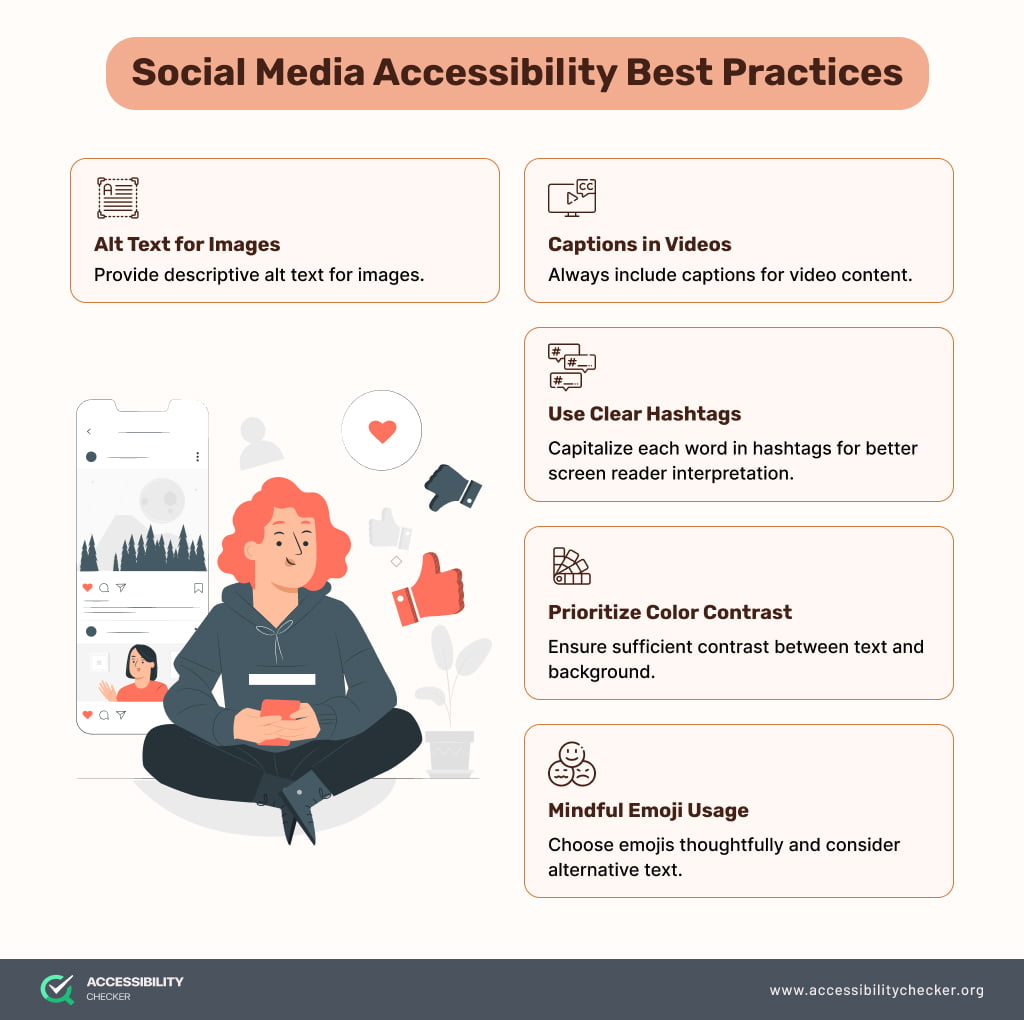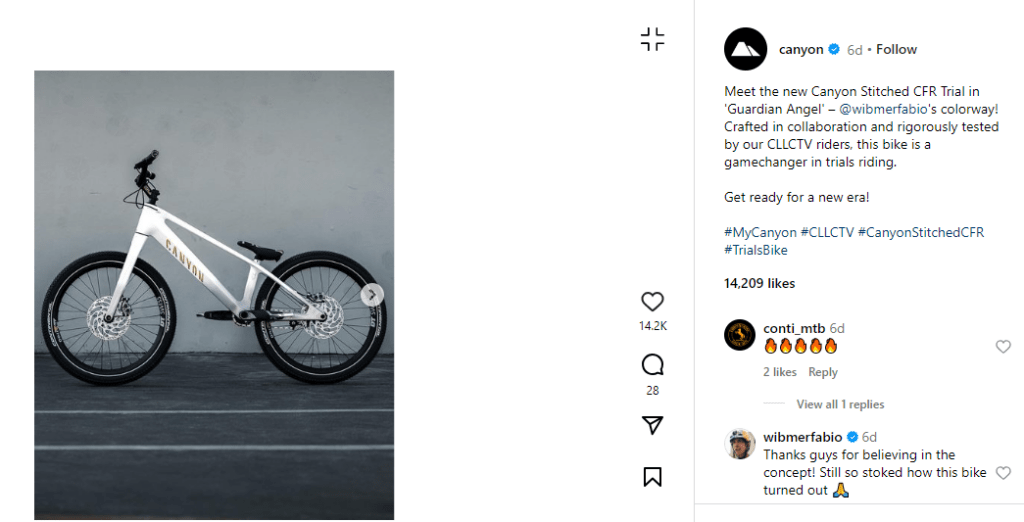Even though there has been some form of social media since 1997, it was only in 2004 when Facebook launched that social media really started bringing people together.
Unfortunately, even though social media platforms are designed for connection and engagement, it’s still possible to exclude people.
Scrolling through your social media feeds may be second nature to you, but it can be a much trickier task for someone with a disability.
Brands that rely on social media to promote their products and services should be prioritizing social media accessibility and for good reasons.

Social media accessibility is the process of developing social media posts that cater to all followers, including those with disabilities.
Content that doesn’t comply with accessibility best practices can limit some users from understanding and enjoying it.
These best practices, which are based on the Web Content Accessibility Guidelines (WCAG), cater to users with visual, hearing, cognitive, and mobility impairments, ensuring nobody is excluded.
Did you know that one in four Americans (1) have a disability? And, if we look at global stats, we will see that around 16% of the world’s population (2) is living with some form of disability.
Failing to comply with social media accessibility standards means you’re potentially excluding a large portion of your potential customer base.
It’s true that many users rely on assistive technology to browse the web, but they can only engage with content if marketers have complied with the necessary accessibility requirements.
Over and above inclusivity being important, brands that don’t focus on accessibility are going against global disability acts such as the ADA and the AODA in Canada, which can result in costly penalties and lawsuits. Not to mention the brand damage that would follow.
Before we delve into our essential social media accessibility checklist, let’s look at a few content creators and brands that are getting it right.
A post such as this that contains text within an image would be impossible for some readers to engage with even with the help of assistive technology. Seanad CEG counteracts this problem by placing the entire letter in the Alt text field.

To ensure that even people with hearing disabilities can enjoy this video, Insider Food uploaded its content with subtitles.

This social post demonstrates the importance of using standard, accessible fonts when creating your social media posts. Using different fonts to make your posts stand out may seem like a good idea, but it’s only once you experience what your copy sounds like through a screen reader that you realize how often you could be isolating some of your followers.
https://twitter.com/i/status/1083073242330361856
Canyon gets this post right by keeping the text simple and using hashtags instead of countless emojis, which can often cause a confusing experience for followers with visual impairments.

If you’re ready to start making your social media posts more accessible to your followers, here are the best practices you need to follow:
Alt text fields are not there for keywords, image credits, or calls to action. They should be used to add short and clear descriptions to your images and GIFs. This way, a screen reader can describe the image to a follower.
When creating your alt text, decide what information would be most valuable to a user and provide the most context to your post. You don’t need to include “image of” in your alt text.
And even though alt text is not traditionally used with videos, it still helps to add a clear video description wherever possible, even if it’s in the comments.
X, Facebook, LinkedIn, and Instagram all have options for you to add alt text.
It can be fun to play around with fonts when you’re creating your social media posts, but it doesn’t help if they’re excluding certain followers.
Keep your text accessible by using a standard font and avoiding all caps. Words that are capitalized can be seen as acronyms by screen readers.
Clear, short sentences that are written in plain language are always best. It also helps to keep your hashtags easier to read by capitalizing the first letter of each word. So, instead of #accessibilitychecker, you use #AccessibilityChecker.
Lastly, keep any special characters to a minimum as some screen readers cannot decipher them. Certain characters like ampersands will also be read aloud, which can be confusing.
Another way to ensure that all of your followers enjoy being a part of your social media community is to use inclusive language in your post copy.
Your text should always be respectful and free of discriminatory, offensive, and biased terms. Be aware of how you use gendered language and make a point of putting people first.
There’s no denying that emojis add some character to social media posts but they can be a nightmare for disabled users.
Screen readers do understand emojis and will read them out loud. However, using too many can make your sentences sound ridiculous, especially if you’re using an emoji after every other word.
Rather keep emojis to a minimum and keep them at the end of your post.
Videos have become more popular than standard image-based posts on social media. However, without subtitles, some of your followers cannot engage with your video content.
Subtitles make your videos accessible to people with hearing and cognitive disabilities. They are even useful for viewers who don’t want the sound on in a quiet or crowded space.
When creating subtitles, make sure they are visible against a background and won’t be covered by other video or platform elements.
You can also take things one step further by including closed captions, which include additional context such as sound and music.
Auto captions that are powered by AI technology can be useful, but they’re not always accurate, so it’s best to create them yourself or at least check the quality afterwards. YouTube is an example of a platform that will automatically generate subtitles for you, but you may need to edit them.
Facebook, Instagram, TikTok, X, and even LinkedIn give you the option to add captions to your videos.
Adding alt text to your images is not enough, your visuals also need to be accessible.
To begin with, pay attention to color contrast. High-contrast images are far easier to understand. Aim for a color contrast ratio of 4:5:1 for each of your graphics. You also want to make sure you’re not only using color to convey meaning as this could exclude colorblind users.
When it comes to graphics with text, keep the text to a minimum. If you really want to provide more information, use the post caption, comments, or a landing page.
For images that include people, find ways to change things up. Your followers are paying attention to the people you use in your posts, so make a point of using different genders, ages, and races. You can even showcase people with disabilities if it makes sense to do so.
Lastly, if any of your videos might impact photosensitive people, make sure you include a warning.
There are a number of tools that you can integrate into your content creation processes to ensure you’re meeting the necessary accessibility requirements.
Color Contrast Checker. AccessibilityChecker has a free color contrast tool that you can use to determine whether you are achieving the correct color contrast ratios.
Hemingway. Test how easy your content is to read and understand by running it through the Hemingway editor. A score of 9 is what you want to aim for.
Color Oracle. Want to make sure you’re not excluding colorblind followers? Color Oracle is a color blindness simulator that can help.
CapCut. Save yourself some time by using CapCut to automatically add captions to your Facebook, TikTok, and Instagram content. Just be sure to give them a read before uploading.
VoiceOver and TalkBack. Download a real screen reader to test your content and understand how a user may experience it. VoiceOver is for Mac, while TalkBack can be used on Windows.
When it comes to creating accessible social media content, it helps to work accessibility into all of your processes right from the start. Plus, there are a number of tools that can help you refine your processes.
Developing content with the disabled community in mind will not only protect your brand but help it thrive! An accessible social community is an inclusive one.
Yes, WCAG does apply to social media because these platforms are designed to reach a broad audience, many of which will include disabled users. To comply with web accessibility standards and promote a more inclusive brand experience, it’s important to consider the necessary accessibility best practices when creating social media content.
X has the most accessibility features when compared to other social media platforms. The brand is also revered for its representation of employees with disabilities. While Facebook and Instagram have some accessibility features, these platforms could do more for the disabled community.
In 2024, inclusive web design isn’t just a trend; it’s a moral imperative. From alt text to keyboard navigation, every detail matters. For Las Vegas marketing firms, embracing accessibility isn’t just about reaching a wider audience—it’s about embodying true brand ethos.